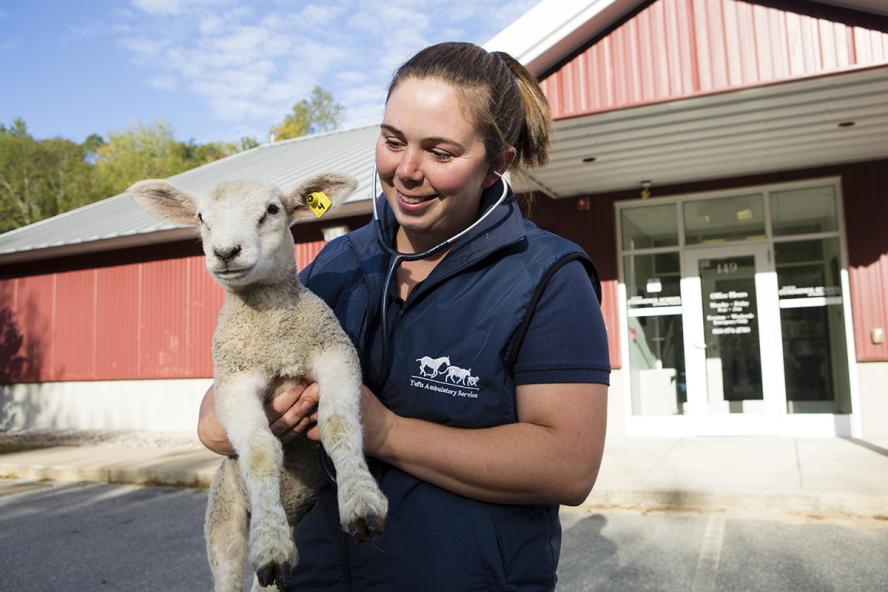-
About
- Leadership & Faculty
- News & Events
-
Academics
- Graduate
- Advanced Clinical Training
- Continuing Education
- Academic Departments
- Academic Offices
- Simulation Experiences
-
Student Life
- Offices
-
Research
-
Hospitals & Clinics
- Emergency Care
- Hospital Services
-
Community Outreach
- Volunteer
Exploring Sialidosis in Sheep
NIH grant enables collaborative research between Cummings School of Veterinary Medicine and UMass Chan Medical School

A collaboration between Cummings School of Veterinary Medicine at Tufts University and UMass Chan Medical School, supported by a grant from the National Institutes of Health (NIH), has led researchers to explore sialidosis in sheep. This research may eventually lead to the approval of gene therapy to treat human patients who are diagnosed with this debilitating and fatal disease.
Sialidosis is a rare lysosomal storage disease caused by a mutation in the gene that encodes neuraminidase, according to Dr. Rachael Gately, assistant clinical professor in Cummings School’s Department of Ambulatory Medicine and Theriogenology (AMT). Neuraminidase is an enzyme that breaks down glycoproteins within the lysosome, and when neuraminidase is dysfunctional, it leads to toxic accumulation of glycoproteins that ultimately cause organ and tissue failure. There are two types of sialidosis. Type I patients have adolescent onset with ataxia, seizures, and vision loss with death in midlife, and type II patients are more severe with early onset and symptoms including an enlarged liver, kidney, and spleens, coarse facial features, developmental delay, and death in childhood. Approximately 100 people across the globe each year are affected by sialidosis.
Gately has teamed with Dr. Heather Gray-Edwards, an assistant professor at UMass Chan Medical School, who studies human genetic neurologic diseases. Using Gately’s particular interest in assisted reproductive techniques — including knowledge of semen cryopreservation, embryo collection, and embryo transfer in sheep and cattle — they are exploring the possibility of treating sialidosis in the generation of a new CRISPR/Cas9 sheep model of sialidosis.
Generally, clinical trials pass through efficacy testing in a mouse model and safety testing in a large animal. Once a treatment’s effectiveness and safety have been proved in both models, it can be taken to humans. However, treatments that are effective in mice often don’t work in patients to the same degree. By using livestock models of human genetic diseases, further therapeutic effectiveness can be demonstrated in something the same size with similar complexity and lifespan as humans while meeting the Food and Drug Administration (FDA) requirement of testing in a non-rodent species. Using gene therapies, Gray-Edwards’ team has successfully demonstrated proof of concept efficacy of gene therapy in sialidosis mice, and the next step is to test this therapy in a sialidosis sheep.
Although sialidosis does not naturally occur in sheep, the team is creating the model. Gately and Cummings School’s Farm team harvest embryos, and the Gray-Edwards team edits the sheep genome in the lab to create a mutation responsible for the disease. Gately and her team then put the embryos back into normal recipient ewes from a flock of Jacob sheep housed at Cummings School’s Farm which are studied collaboratively and will be used to test the gene therapy.
“When those lambs are born, we study the disease to ensure that a sheep is a good model for that disease,” says Gately. “If so, we’ll pursue further grants to treat it, and if effective, advance it to humans.” Currently, there is no effective treatment for sialidosis.
Collaborative work on Tay-Sachs disease
Successful research on another disease led Gray-Edwards and Gately to focus on sialidosis. Gately explains, “When Dr. Gray-Edwards came to UMass six years ago, with her came a flock of Jacob sheep that naturally carry another neurologic disease that humans also have — Tay-Sachs disease.” UMass and Tufts agreed that the flock would be housed at Cummings School and managed for the studies. “This also created a great opportunity to access the sheep for veterinary school training,” Gately adds.
Gately and Gray-Edwards met to determine how the Tay-Sachs research could be improved using Gately’s skills in advanced assisted reproduction. The UMass lab could use that information to advance the research.
“Initially, we were focused on producing more of the Tay-Sachs models because this genetic disease can, in theory, be treated with gene therapy and could eventually become FDA-approved for treating humans,” Gately explains.
Tay-Sachs disease has completed the aforementioned clinical trial process, as Gray-Edwards treated Tay-Sachs in sheep and showed the treatment is effective. “We have sheep on campus that are living well beyond their life expectancy with that disease after being subjected to gene therapy,” Gately says. Because of this, patients affected by Tay-Sachs worldwide have traveled to the United States to investigate this treatment option further.
Encouraged by that success, Gately and Gray-Edwards wondered what other diseases they could cure together based on their success with this naturally occurring disease that afflicts both sheep and humans. This success led them to investigate sialidosis.
Gately enjoys the challenge of research and has sharpened her clinical skills in the field of assisted reproductive techniques by repeating the process and troubleshooting issues. “I love tying my clinical experience to something more advanced,” she says while admitting that her passion for this research is derived from a personal connection. “My mom has a rare genetic disease, a neurologic disease that typically affects individuals in their 40s, and that’s what inspires me to conduct research utilizing animal models.”
Gately believes that personal experience can be a significant motivator. She says, “Although we’re not studying that specific disease, research gives me hope that the disease affecting my mother could be in the queue to be looked at someday. And maybe Tufts will be one of the institutions investigating potential medical treatments for it.”